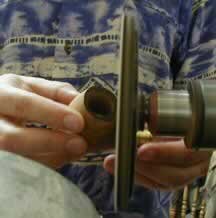Trever Talbert on Detail Shaping
From Creating, Briar, by Trever Talbert, from his website, and used by permission.
Detail Shaping
Depending on what style of pipe I'm making, this can either be a short stage or the longest of them all. Now that I have a drilled stummel, it's time to start turning it into something people will recognize as a pipe. The first step is the general shaping, pictured below. This is where the flat edges and the base of the bowl are sanded away to give the bowl its proper look. This pipe is being rounded off around the bowl using a flat sanding disc.
The next step is to move to the detailing table, where I will embark on what can occasionally be an extremely long process of tweaking the shape until I'm happy. Complex forms such as the tentacled Cthulhu pipes or carved figures can take just about forever to get right, and all that work happens here. On standard shapes such as billiards and pokers, however, this is a simple process and just takes a little tuning to get the best look. I use two flexible carving tools with various sanding drums and cutters, and then move on to hand files for the fine work. Below is pictured the general area where this work is done, which is always a mess. One can see the smaller flex-shaft carver and the handpiece of the larger foot-pedal-operated carver, as well as the selection of detail files on hand.
The final detailing of the shape is done using hand files, both flat and round. Here I am using a large file to get the join of the shank and bowl right before moving on to smaller and smaller files as I make the join more defined.
The stummel is now shaped and ready for its finishing stages, which may include rustication and/or sandblasting, plus fine sanding, curing, and coloring. This stummel has been lightly sandblasted already.



